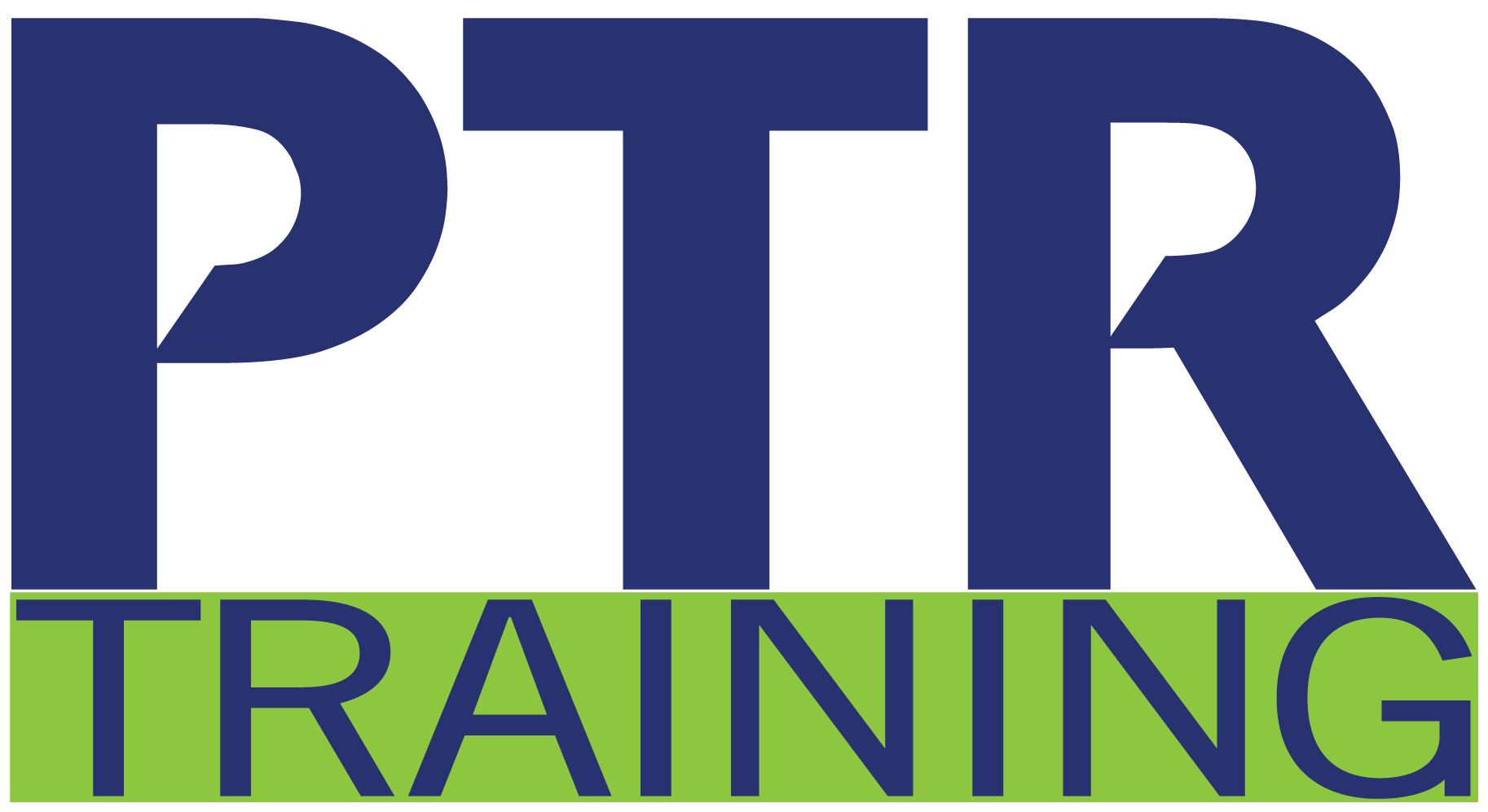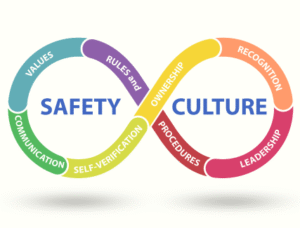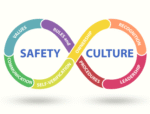Creating a supportive, safe work culture that encourages open communication and constructive feedback amongst managers and employees.
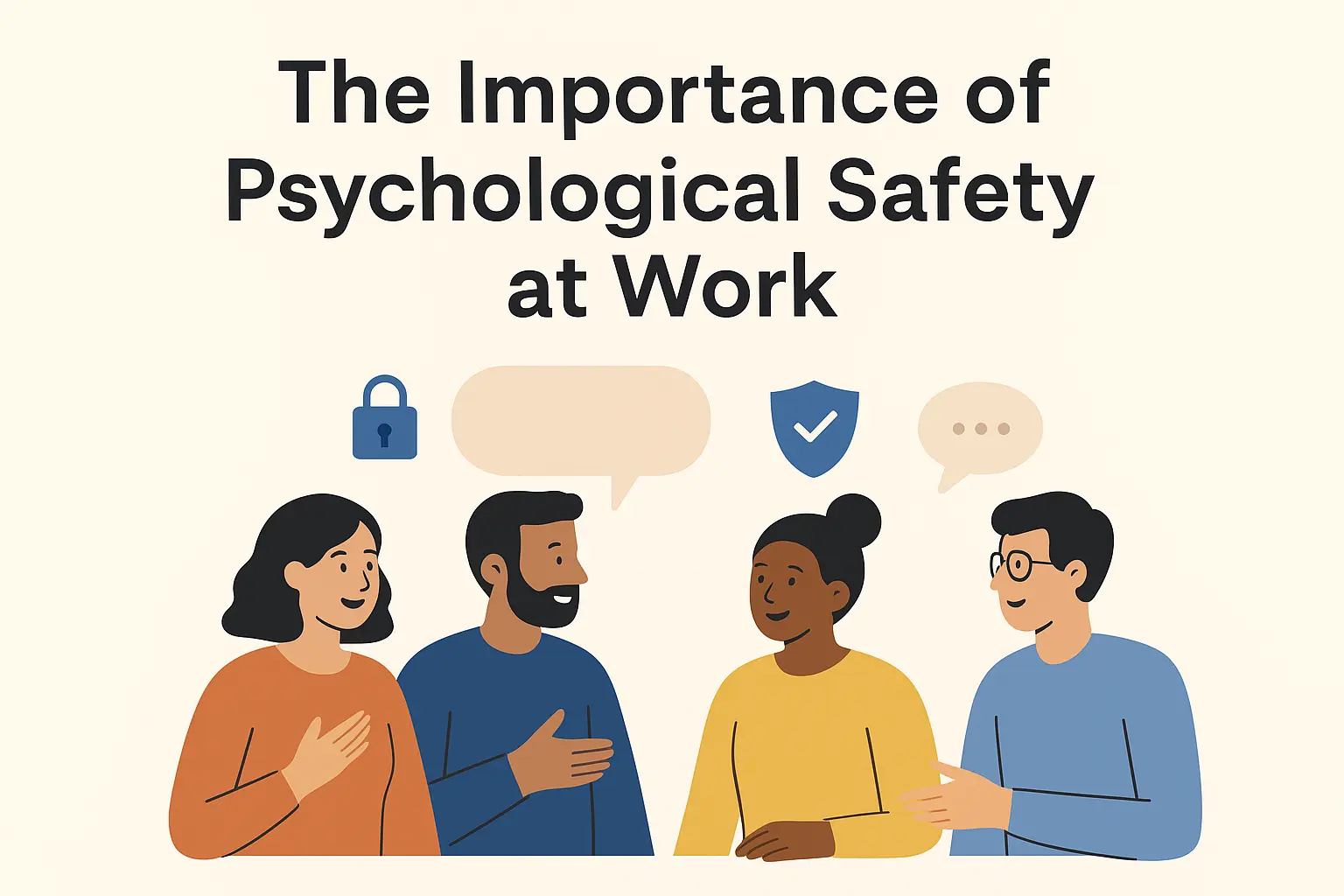
Walk into any successful organization, and you’ll notice something powerful — not the fancy office or the tech tools, but the way people talk to each other. You’ll see employees sharing ideas freely, challenging assumptions respectfully, and admitting mistakes without hesitation. That’s not luck — that’s psychological safety at work.
Now imagine the opposite: a meeting where everyone stays quiet, afraid to ask “what if” or “why.” It’s not that the team lacks talent — it’s that fear has taken the driver’s seat. When people don’t feel safe to speak up, creativity stalls, innovation fades, and engagement drops.
Psychological safety is what separates teams that just function from those that flourish. It’s the invisible thread that holds trust, collaboration, and performance together — especially in a world where change is constant, and uncertainty is the norm.
And the truth is, building it isn’t optional anymore. For leaders who want their teams to thrive — not just meet deadlines — psychological safety must become a core leadership priority, not a “nice-to-have.”
What Is Psychological Safety?
At its core, psychological safety means creating an environment where employees feel comfortable being open, honest, and vulnerable. It’s when people know they can express concerns, admit mistakes, or offer new ideas — without the fear of ridicule or punishment.
When employees feel psychologically safe, they are:
- More engaged — they bring their whole selves to work
- More innovative — they take calculated risks and suggest creative ideas
- More resilient — they recover faster from setbacks
- More collaborative — they support one another instead of competing
Simply put, psychological safety allows teams to thrive, not just survive.
Psychological Safety at Work Course
Why Psychological Safety in the Workplace Matters?
When psychological safety is high, teams thrive. They communicate more freely, learn faster, innovate more reliably, and stay engaged longer. Conversely, when it is lacking, the cost is real, from employee turnover and disengagement to lost opportunities and stalled innovation.
Here are some key data-driven insights:
- Research from Boston Consulting Group (BCG) found that employees in low-safety workplaces face about a 12% risk of quitting within a year, compared to just 3% in high-safety environments.
- A survey by John Wiley & Sons found that only 53 % of individual contributors feel safe taking risks at work — a clear gap compared to higher-level managers.
- According to a McKinsey survey, 89% of employees believe that psychological safety in the workplace is essential.

These findings underscore the importance of psychological safety in the workplace, extending beyond feel-good culture — it directly impacts organizational results.
1. Impact on Engagement and Productivity
When employees believe they can share ideas, voice concerns, and admit mistakes without reprisals, they are far more likely to stay engaged. Engagement drives productivity — and productivity drives outcomes.
High psychological safety environments motivate individuals to bring their best selves to work, ask questions, pivot when needed, and learn from errors rather than hide them. This is why psychological safety at work is so closely linked to productivity gains.
2. Innovation and Risk Taking
Innovation requires experimentation. When team members feel safe, they are more willing to propose bold ideas, challenge the status quo, and explore new ways of working. Without psychological safety, risk-taking is stifled — and innovation slows.
For leaders at PTR and similar organisations, fostering psychological safety means enabling teams to experiment, learn, iterate, and improve — all within a safe framework.
3. Building Trust and Team Resilience
At its core, psychological safety is built on trust. Teams that trust one another bounce back faster from setbacks, manage change more effectively, and stay resilient in volatile environments.
In contrast, if employees fear blame or retribution, they withhold information, avoid admitting mistakes, and hide problems, which suppresses the very channels of learning and improvement.
4. Retention, Well-being, and Inclusion
Retention isn’t just about salary or perks. Employees choose to stay (or leave) based on whether they feel safe, valued, and respected. Moreover, psychological safety supports well-being. When people can speak openly about difficulties, ask for help, and know they will be supported, stress and burnout are less likely.
Inclusive workplaces benefit enormously. Psychological safety levels the playing field — boosting retention particularly for underserved or underrepresented groups.
5. The Leadership Imperative
The importance of psychological safety doesn’t rest solely on teams — it begins with leadership. How leaders model behavior, respond to concern or failure, and create norms of openness sets the tone.
For example:
- Leaders admit their own mistakes — signalling that vulnerability is acceptable.
- They actively invite input from all team members and respond respectfully.
- They reward curiosity, not just flawless execution.
These leadership behaviors cultivate an environment where psychological safety thrives.
Practical Steps to Build Psychological Safety at Work
Having established why psychological safety matters, here are practical, research-informed steps your organisation (and teams) can take to embed it into day-to-day work.
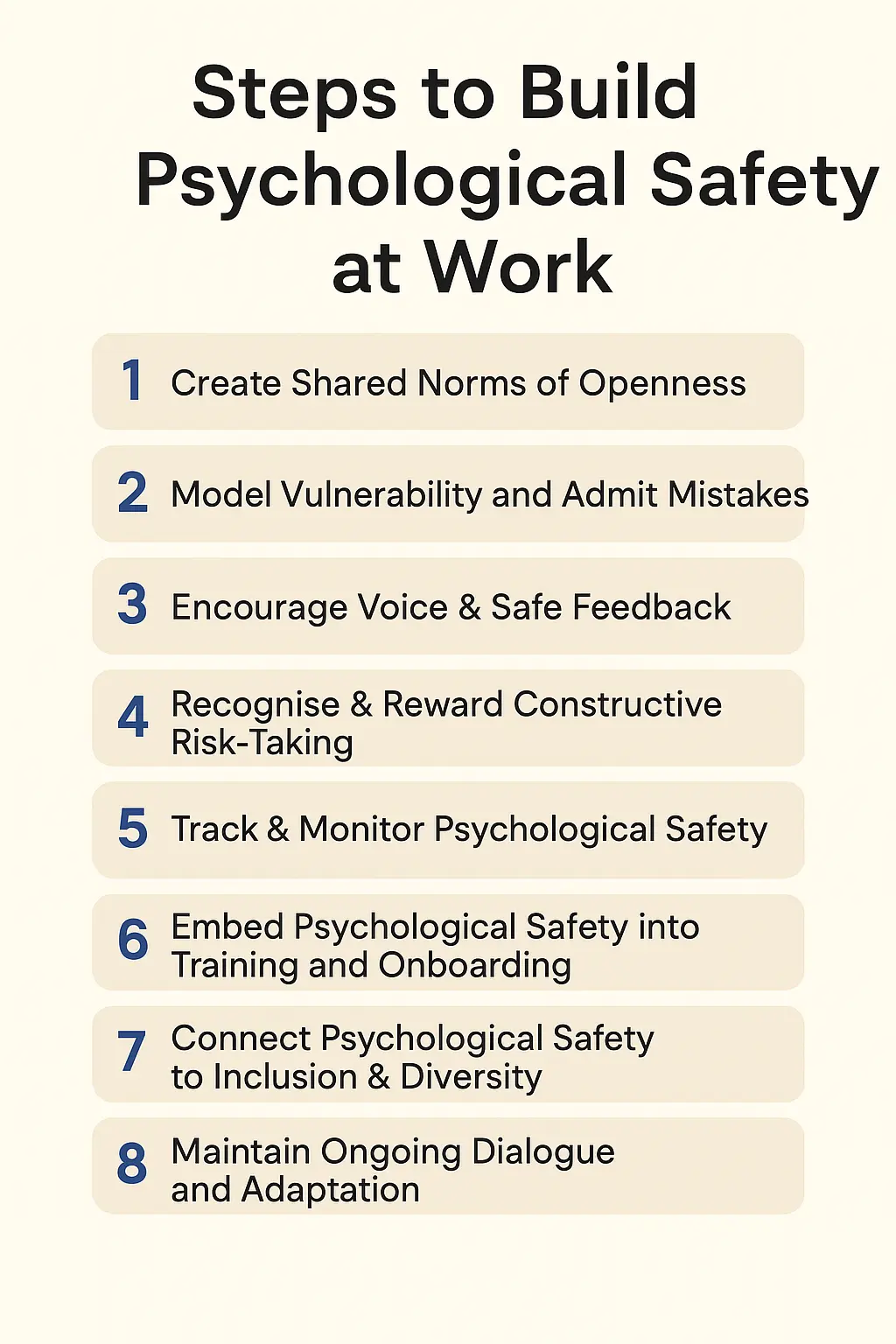
Step 1: Create Shared Norms of Openness
Define collective agreements around how the team will communicate, handle mistakes, give feedback, and make decisions. Norm clarity strengthens psychological safety. Host a session to co-create these norms and revisit them regularly.
Step 2: Model Vulnerability and Admit Mistakes
When leaders show they do not have all the answers, it opens space for others to ask questions and share ideas. Mistakes become learning opportunities rather than threats.
Step 3: Encourage Voice & Safe Feedback
Encourage all team members — especially quieter voices — to speak up. Use methods like round-robin check-ins, anonymous suggestion boxes, and structured retrospective sessions. A culture of safe feedback contributes to the importance of psychological safety.
Step 4: Recognise & Reward Constructive Risk-Taking
When someone tries something new and it doesn’t work out, instead of blame, highlight the learning and discuss next steps. This rewards both effort and transparency.
Step 5: Track & Monitor Psychological Safety
Just as you track performance metrics, measure psychological safety periodically. Simple survey items (e.g., “I feel safe to speak up”) can highlight areas of concern. Use findings to guide improvement.
Step 6: Embed Psychological Safety into Training and Onboarding
Make psychological safety part of your onboarding for new employees and manager training. When it’s part of the system, not just a message, it becomes real.
Step 7: Connect Psychological Safety to Inclusion & Diversity
Psychological safety is especially critical for diverse teams. Ensuring that all voices feel safe to contribute elevates innovation and team performance.
Step 8: Maintain Ongoing Dialogue and Adaptation
Workplaces change. What made people feel safe two years ago may not today. Regular check-ins, pulse surveys, and open-ended dialogues help keep your psychological safety efforts relevant.
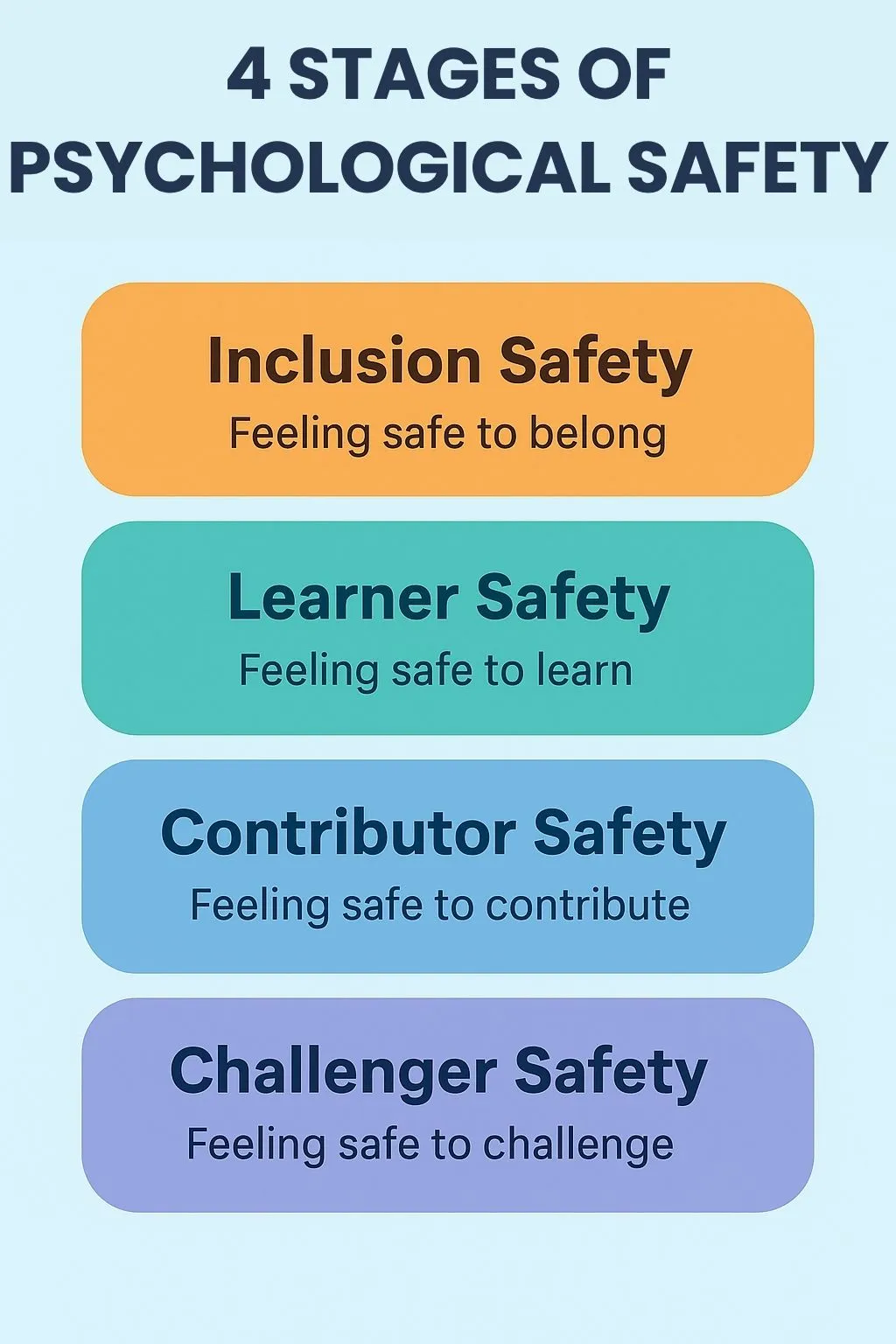
The 4 Stages of Psychological Safety
Dr. Timothy R. Clark introduced the 4 stages of psychological safety, which describe the progressive steps teams experience as they grow more open and inclusive. Understanding these stages helps leaders identify where their team stands — and what’s needed next.
1. Inclusion Safety
This is the foundation. It’s when team members feel accepted for who they are. Everyone feels included, respected, and free to show up authentically — regardless of background, experience, or perspective. Leaders can build a culture of inclusion and safety by showing genuine curiosity about their team members and ensuring everyone has a voice at the table.
2. Learner Safety
At this stage, employees feel safe asking questions, giving feedback, and experimenting. Mistakes are viewed as part of the learning process, not as failures. Leaders encourage curiosity and make learning visible — by saying, “Let’s test this idea” or “What can we learn from this outcome?”
3. Contributor Safety
Now, team members feel confident sharing ideas, actively participating, and contributing to team goals. Their opinions are heard, valued, and acted upon. This stage requires leaders to empower employees — not just assign tasks, but invite input on how work can be improved.
4. Challenger Safety
This is the highest level — when employees feel safe to challenge the status quo. They can question decisions, suggest better ways, and raise concerns without fear of backlash. This stage fosters innovation and continuous improvement — the hallmarks of a truly high-performing, psychologically safe team.
The Impact of Psychological Safety on Team Performance
When employees feel psychologically safe, the ripple effects are visible across performance metrics:
- Teams with high psychological safety report greater creativity and collaboration.
- Employees are more likely to stay with organizations that encourage open dialogue and mutual respect.
- Companies that prioritize psychological safety often experience stronger decision-making and faster problem-solving, since people share information more freely.
Leaders who invest in creating a safe, respectful, and inclusive workplace aren’t just doing what’s right — they’re doing what’s smart for business.
Learn to Foster a Safe and Respectful Workplace
If you want to learn how to foster an environment of greater psychological safety in the workplace — and you’re ready to take actionable steps to improve communication, civility, and trust — explore our Workplace Civility Course.
This program is designed to help managers and teams build respectful work environments where everyone feels valued and empowered to contribute because psychological safety is a leadership skill that drives lasting results.
Conclusion
The importance of psychological safety at work cannot be overstated. It’s what transforms teams from cautious and compliant to confident and creative.
As leaders, our role is to nurture environments where every voice matters — because when people feel safe, they don’t just do more work. They do their best work.
If you're ready to invest in psychological safety and unlock your team's full potential, connect with us to learn more about our leadership and management training courses.
FAQs
1. What is psychological safety at work?
Psychological safety at work means employees feel comfortable expressing ideas, asking questions, sharing concerns, or admitting mistakes without fear of embarrassment or punishment. It’s about creating an environment of trust and respect that encourages open dialogue.
2. Why is psychological safety paramount in the workplace?
Psychological safety is important because it enables collaboration, creativity, and innovation. When people feel safe to speak up, they contribute more effectively, make better decisions as a team, and drive higher overall performance.
3. How does psychological safety affect employee performance?
Teams with higher psychological safety tend to be more engaged, proactive, and solution-focused. When employees feel supported, they’re more likely to take ownership of their work, share ideas freely, and go beyond their basic responsibilities.
4. What happens when psychological safety is missing at work?
When psychological safety is missing, employees tend to stay silent, avoid risk-taking, and disengage. This leads to reduced creativity, poor communication, higher turnover, and a lack of innovation across the team or organization.
5. How does psychological safety support diversity and inclusion?
Psychological safety ensures every voice is heard and valued, regardless of background or position. It helps diverse perspectives thrive by creating an environment where individuals can share unique insights without fear of bias or judgment.
